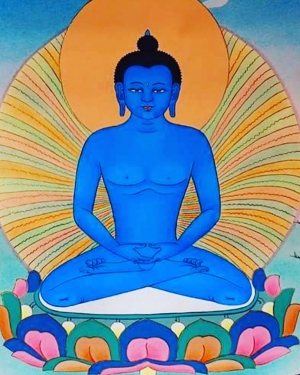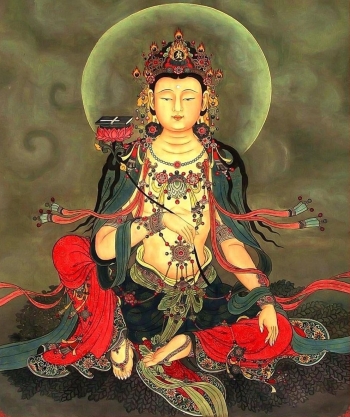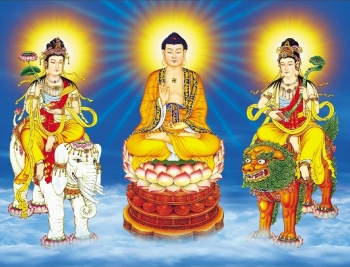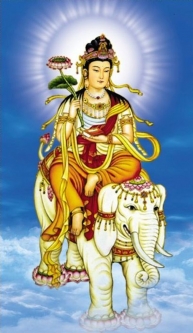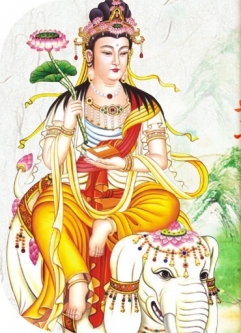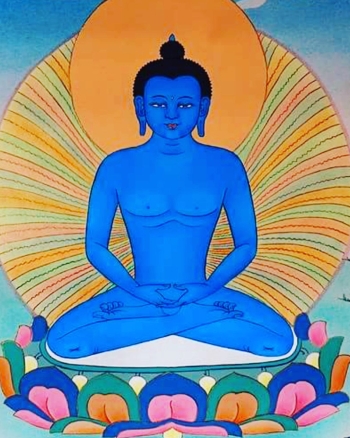Samantabhadra
1. Samantabhadra
Samantabhadra (lit. Universal Worthy
, All Good
) is a Bodhisattva in Buddhism associated with practice and meditation.
Together with Gautama Buddha and the Bodhisattva Mañjuśrī, he forms the Śākyamuni Triad in Mahāyāna Buddhism.
Samantabhadra is the patron of the Lotus Sūtra and, according to the Avataṁsaka Sūtra, made the 10 Great Vows which are the basis of a Bodhisattva.
In Chinese Buddhism, Samantabhadra is known as Pǔxián and is associated with action, whereas Mañjuśrī is associated with prajñā (transcendent wisdom).
In Japan, this Bodhisattva is known as Fugen Bosatsu, and is often venerated in Tendai and Shingon Buddhism, and as the protector of the Lotus Sūtra by Nichiren Buddhism.
In Śrī Lanka, he is known as Saman and is regarded as the guardian of the island of Śrī Lanka.
In the Nyingma school of Tibetan Buddhism, Samantabhadra is also the name of the Ādi-Buddha, often portrayed in indivisible union (yab-yum) with his consort, Samantabhadrī.
In wrathful form he is one of the 8 Herukas of the Nyingma Mahāyoga and he is known as Vajramrtra.
2. Origins
In the Lotus Sūtra, Samantabhadra is described at length in the epilogue, called the Samantabhadra Meditation Sūtra (Chinese: Guān Pǔxián Púsà Xíngfǎ Jīng), with special detail given to visualization of the Bodhisattva, and the virtues of devotion to him.
Samantabhadra is also a key figure in the Avataṁsaka-sūtra, particularly the last chapter, the Gaṇḍavyūha-sūtra:
In the climax of the Gaṇḍavyūha-sūtra, the student Sudhana meets Samantabhadra Bodhisattva, who teaches him that wisdom only exists for the sake of putting it into practice; that it is only good insofar as it benefits all living beings.
In the Avataṁsaka-sūtra, the Buddha states that Samantabhadra Bodhisattva made 10 Great Vows in his path to full Buddhahood:
- To pay homage and respect to all Buddhas.
- To praise the Thus Come One-Tathāgata.
- To make abundant offerings. (e.g. give generously)
- To repent misdeeds and evil karmas.
- To rejoice in others' merits and virtues.
- To request the Buddhas to continue teaching.
- To request the Buddhas to remain in the world.
- To follow the teachings of the Buddhas at all times.
- To accommodate and benefit all living beings.
- To transfer all merits and virtues to benefit all beings.
The 10 Great Vows have become a common practice in East Asian Buddhism, particularly the 10th vow, with many Buddhists traditionally dedicating their merit and good works to all beings during Buddhist liturgies.
3. In Mahāyāna Buddhism
Unlike his more popular counterpart Mañjuśrī, Samantabhadra is only rarely depicted alone and is usually found in a trinity on the right side of Śākyamuni, mounted on a white elephant.
In those traditions that accept the Avataṁsaka Sūtra as its root instruction, Samantabhadra and Mañjuśrī flank Vairocana Buddha, the central Buddha of this particular Sūtra.
Known as Pǔxián in Chinese, he is sometimes shown in Chinese art with feminine characteristics, riding an elephant with 6 tusks while carrying a lotus leaf parasol (Sanskrit: chattra), bearing similar dress and features to some feminine depictions of Guanyin.
It is in this guise that Samantabhadra is revered as the patron Bodhisattva of the monasteries associated with Mount Emei in western China.
Some believe that the white elephant mount of Samantabhadra was the same elephant that appeared to Queen Māyā, the mother of the Buddha, to herald his birth.
Mahāyāna esoteric traditions treat Samantabhadra as one of the 'Primordial' (Sanskrit: Dharmakāya) Buddhas, but the main primordial Buddha is considered to be Vairocana.
4. Tibetan Buddhism
In Tibetan Buddhism, Samantabhadra (Tibetan: Küntu Zangpo) is a name that refers to 2 different beings:
a) Bodhisattva Samantabhadra, one of the 8 main Bodhisattva attendants of Śākyamuni Buddha.
b) The Primordial Buddha (Ādi-Buddha) Samantabhadra in Tibetan Nyingma, or Ancient, School.
Samantabhadra appears in the Kunjed Gyalpo Tantra (Kulayarāja Tantra), as the Primordial Buddha, the 'embodiment' (Sanskrit: kāya) or 'field' (Sanskrit: kṣetra) of 'timeless awareness, gnosis' (Sanskrit: jñāna) awakened since before the very beginning.
Dzongsar Khyentse Rinpoche following the Nyingmapa Dzogchen tradition qualifies the nature and essence of Samantabhadra as follows:
Samantabhadra is not subject to limits of time, place, or physical conditions. Samantabhadra is not a coloured being with two eyes, etc.
Samantabhadra is the unity of awareness and emptiness, the unity of appearances and emptiness, the nature of mind, natural clarity with unceasing compassion that is Samantabhadra from the very beginning.
Dzongsar Khyentse Rinpoche
'The Mirror of the Mind of Samantabhadra’ is one of the 17 Tantras of Dzogchen Upadeśa.
5. In Śrī Lanka
Śrī Lankan people venerate Samantabhadra Bodhisattva as Saman (also called Sumana, Samantha, Sumana Saman).
The name Saman means the rising morning sun
.
The god Saman is considered to be one of the guardian deities of the island as well as a protector of Buddhism. His main shrine is located in Rātnapura, where there is an annual festival held in his honour
